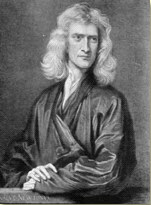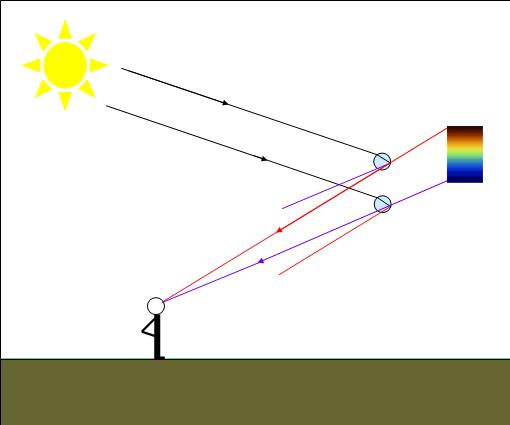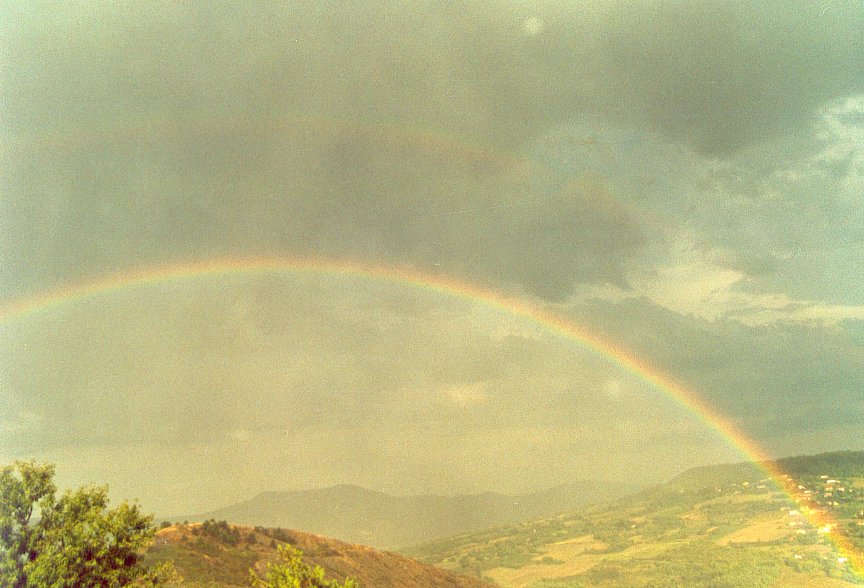|
|
 |
|
|
|
 |
| |
|
|
 |
Clouds & Particles
Basics |
Rainbows
Rainbows have always fascinated people and are the subject of many legends. Irish people say that there is a pot of gold at the end of a rainbow, Indians believe that a rainbow is the bridge between life and death and the Book of Genesis in the Bible tells that the rainbow is the sign of covanant between God and life on Earth. In reality although rainbows are so beautiful that they seem magic, they are simply a meteorological phenomenon.
|
|
|
|
|
 |
 |
 |
|
1. Sir Isaac Newton (1643 - 1727). Source: NASA.
|
|
 |
The colours of white light
The first person to explain how the rainbow formed was the famous English Scientist Issac Newton. His discovery came about in the 17th Century and was based on the previous work by Descartes. Newton showed that, although sunlight appears white, is made up of many different colours that the human eye can't see separately.
|
|
Light is, in fact, made of a series of colours: red, orange, yellow, green, blue, indigo and violet. These colours make up the visible spectra. It also comprises two other 'colours' that we canít see: infra-red (which our eyes canít detect but we can feel as heat) and ultra-violet (which causes sunburn).
|
 |
 |
|
2. The Sun's colour spectrum. Source: NASA.
|
The prism
To demonstrate that white light is a mixture of different colours, Newton used a wedge of glass, called a prism. When light passes through a prism, it changes direction and this is called refraction. The angle of refraction is different for each of the colours which make up white light. So seven distinct colours are seen when light passes through a prism (as shown in the picture) and the light is said to be decomposed.
|
 |
 |
 |
|
3. Light refracted by a prism. Author: J. Gourdeau. Click to enlarge (10 K).
|
|
The rainbow
In order to see a rainbow we need both sunlight and raindrops. When water droplets are suspended in the atmosphere, each acts like a tiny prism. When the sunlight shines through the raindrops, the white sunlight is split, or refracted, into its seven component colours and a rainbow forms.
|
 |
 |
4. Each drop act as a prism.
Author: J. Gourdeau. |
|
 |
 |
 |
5. Our eyes see red light coming from droplets of water higher in the sky, while droplets of water lower in the sky send violet light to our eyes. Author: J. Gourdeau. |
|
The shape of the rainbow
There is an angle of 42 degrees from the top of rainbow (the red color) to the observer. And because this angle remains constant, your eyes see a semicircle somewhere in space. If you were in a plane, you may be lucky enough to see a complete circle!
|
 |
 |
|
6. A rainbow would form an entire circle if the ground didn't get in the way.
Author: J. Gourdeau
|
Large raindrops (with diameters of a few millimeters) give bright rainbows, whereas small drops (for example those making up mist) produce paler rainbows.
If its sunny outside, have a go making your own rainbow using water from a garden hose. Water droplets from the sprinkler act in the same way as raindrops do.
|
 |
 |
 |
|
7. Sometimes you can see a second rainbow when the light is reflected twice in the same raindrop. The intensity of this secondary rainbow is much less than that of the main one. Author: J. Gourdeau.
|
|
About this page
author: Dr. Justine Gourdeau - LaMP, Clermont-Ferrand, France
scientific reviewer: Dr. Frederic Szczap - LaMP, Clermont-Ferrand, France
last published: 2003-11-03
|
|
 |
|







